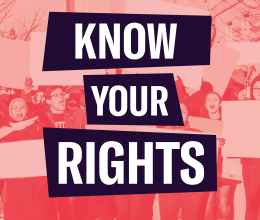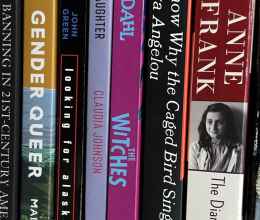
I. A. Constitutional protection of the right to protest
Our fundamental right to protest receives great protection from all five clauses of the First Amendment. Protest manifestly is part of our “freedom of speech,” of “the right of the people peaceably to assemble,” and of our right “to petition government for a redress of grievances.” For some groups, protest is also an expression of “the free exercise” of religion. The “freedom of the press” clause protects the right of all people, professional journalists and others alike, to gather and publish information about protests.
Further, implicit in the First Amendment is a well-protected right to expressive association, that is, a right to join together with likeminded persons to collectively express a shared message, by means of protest or otherwise. According to the U.S. Supreme Court, “the practice of persons sharing common views banding together to achieve a common end is deeply embedded in the American political process.”
The First Amendment provides special protection for protest concerning the performance of government officials and other matters of public concern, and for protest in public forums. The right to protest in public places includes large gatherings (like parades in the streets and rallies in parks), small gatherings (like pickets on sidewalks and vigils on government plazas), and solitary expression (like one person holding a sign or distributing leaflets).
The Illinois Constitution guarantees to the general public the rights to “speak,” to “assemble,” to “consult for the common good,” to “make known their opinions to their representatives,” and “to apply for redress of grievances.” These state constitutional guarantees are even more protective of speech than their federal counterparts.
I.B. The general rule: no regulation of messages
With very few exceptions, government cannot limit protest on public property because of the protest’s viewpoint. Rather, government must be neutral among messages and messengers. Protests can be controversial, unpopular, offensive, or even hateful. Protesters can speak in support of illegal activity, violence, or even the overthrow of our government. Over time, the best way to protect speakers we like is to protect speakers we don’t like – such as the neo-Nazis who sought to protest in Chicago’s Marquette Park in the 1970s.
I.C. Three exceptions: incitement, threats, and fighting words
The First Amendment does not protect a few narrow categories of expression. Most importantly here, the First Amendment does not protect “incitement,” meaning speech intended and likely to cause imminent law-breaking. For example, the First Amendment does not protect a speaker who urges an angry crowd to immediately attack someone or destroy their property. Also, the First Amendment does not protect “true threats” directed against a particular person who would reasonably perceive in the message a danger of violence.
“Fighting words” are also unprotected. These are words directed at a particular person, face-to-face, which might provoke an ordinary reasonable person to violence, such as by calling them an offensive name and then “clucking like a chicken.” This narrow category of speech does not include political messages directed at a general audience, even if especially inflammatory, such as flag burning, or displaying a swastika at a neo-Nazi rally in a Jewish community, or wearing a jacket bearing the words “fuck the draft” in a courthouse. On the other hand, an especially provocative and angry face-to-face shouting match between a protester and a bystander might be seen by a police officer as fighting words and thus give rise to arrest.
Abusive words are less likely to be unprotected “fighting words” if they are directed at police officers, who are expected to exercise greater self-restraint, due to their office and training. As a practical matter, however, protesters will usually be best served by speaking respectfully to everyone, including police officers.
I. D. Counter-protest
When one group disagrees with the message of another group, the First Amendment protects the right to counter-protest at the site of a protest. Police must ensure that the two opposing groups do not silence or harm each other. Police may do so by separating the opposing groups, but should allow them to be in the same general vicinity.
The First Amendment also protects the right of an individual or small group to express a variety of additional messages to a large protest group at the site of the protest. For example, at a large parade in support of or opposition to a war, a candidate for public office might display campaign signs to the marchers, or a free speech organization might distribute “know your rights” leaflets to the marchers. Government has no legitimate interest in prohibiting multiple expressive activities that, without interfering with each other, can take place in the same public place at the same time.
I. E. No “heckler’s veto”
Sometimes, when a protester expresses a controversial message, a person who hears the message may react violently against the protester. In such situations, it is the job of the police to protect the protester’s right to free speech and their physical safety, and to arrest or otherwise control those who seek to disrupt or attack the protester. Likewise, the police cannot arrest the protester, though their words are provoking a hostile audience reaction. Otherwise, a “heckler’s veto” would undermine our precious First Amendment rights. Thus, a Chicago police General Order allows police to silence a protester in such circumstances only if all available police resources reasonably available have been deployed, efforts to control the hostile audience have failed, and there remains a threat of imminent violence.
Two of the leading U.S. Supreme Court cases that reject a “heckler’s veto” over protest came from Chicago. In the 1940s, the infamous Arthur Terminiello was wrongfully fined $100 because his racist speech in an auditorium provoked an angry and turbulent response from the crowd of 1,000 counter-protesters outside. In the 1960s, the police wrongfully arrested the comedian and civil rights activist Dick Gregory, whose orderly protest against racial segregation in the public schools, in front of the mayor’s home, provoked an unruly reaction from onlookers.
Next Section: When can government require a permit to protest?



